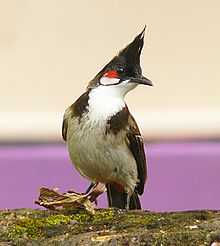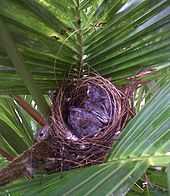Red-whiskered Bulbul
| Red-whiskered Bulbul | |
|---|---|
 | |
| Conservation status | |
| Scientific classification | |
| Kingdom: | Animalia |
| Phylum: | Chordata |
| Class: | Aves |
| Order: | Passeriformes |
| Family: | Pycnonotidae |
| Genus: | Pycnonotus |
| Species: | P. jocosus |
| Binomial name | |
| Pycnonotus jocosus (Linnaeus, 1758) | |
| Synonyms | |
|
Otocompsa emeria | |
The Red-whiskered Bulbul (Pycnonotus jocosus) is a passerine bird found in Asia. It is a member of the bulbul family. It is a resident frugivore found mainly in tropical Asia. It has been introduced in many tropical areas of the world where populations have established themselves. It feeds on fruits and small insects and they conspicuously perch on trees and their calls are a loud three or four note call. The distinctive crest and the red-vent and whiskers makes them easy to identify. They are very common in hill forests and urban gardens within its range.
Taxonomy
The Red-whiskered Bulbul was one of the many species originally described by Carl Linnaeus in 1758 in his Systema Naturae. He placed it along with the shrikes under Lanius.
Local names include Turaha pigli-pitta in Telugu, Sipahi bulbul in Bengali, Krong-hua-juk (กรงหัวจุก) in Thai, and Phari-bulbul or Kanera bulbu in Hindi.[2]
Subspecies
The populations found across their range show a range of plumage variations and some of these are recognized as subspecies:[3][4]
- jocosus, the nominate form is found in Hong Kong[5]
- fuscicaudatus of peninsular India has nearly complete breast band and no white tip to tail
- abuensis of northwestern India (type locality Mount Abu[6]) is pale and has a broken breast band and no white tip to tail
- pyrrhotis of the terai is pale above with white tail tips and widely separated breast band
- emeria of Eastern peninsula and Ganges Delta is warm brown above with a slim bill and a long crest (also introduced into Florida[7])
- whistleri is found in the Andaman Islands and has a warm brown above, a heavier bill and a shorter crest than emeria
- monticola is found in northeastern India and has darker upperparts than pyrrhotis
- pattani is found in Thailand
- peguensis not always recognized was described from southern Burma[8]
Description
The Red-whiskered Bulbul is about 20 centimetres (7.9 in) in length. It has brown upper-parts and whitish underparts with buff flanks and a dark spur running onto the breast at shoulder level. It has a tall pointed black crest, red face patch and thin black moustachial line. The tail is long and brown with white terminal feather tips, but the vent area is red.
The loud and evocative call is a sharp kink-a-joo (also transcribed as pettigrew or kick-pettigrew or pleased to meet you[3]) and the song is a scolding chatter. It is more often heard than seen, but will often perch conspicuously especially in the mornings when they call from the tops of trees. The life span is about 11 years.[9]
Hybrids have been noted in captivity with Pycnonotus cafer, Pycnonotus leucotis, Pycnonotus xanthopygos, Pycnonotus melanicterus and Pycnonotus leucogenys[10] and leucism has been recorded.[11] Several avian malaria parasites have been described from the species.[12]
Distribution and habitat
_I2_IMG_4922.jpg)
This is a bird of lightly wooded areas, more open country with bushes and shrubs, and farmland. Irruptions have been noted from early times with Thomas C. Jerdon noting that they "periodically visiting Madras and other wooded towns in large flocks."[2]
It has established itself in Australia, Los Angeles, Hawaii,[13] and Florida[14] in the United States, and in the Mauritius, Assumption Island[15] and Mascarene Islands.[16][17] In Florida, it is only found in a small area, and its population could be extirpated easily.[18]
The Red-whiskered Bulbul was introduced by the Zoological and Acclimatization Society in 1880 to Sydney, and became well established across the suburbs by 1920, and continued to spread slowly to around 100 km away. It is now also found in suburban Melbourne and Adelaide, although it is unclear how they got there.[19]
Behaviour and ecology

The Red-whiskered Bulbul feeds on fruits (including those of Thevetia peruviana that are toxic to mammals), nectar and insects.[20]
The breeding season is spread out and peaks from December to May in southern India and March to October in northern India.[4] Breeding may occur once or twice a year.[21] The courtship display of the male involves head bowing, spreading the tail and drooping wings.[21] The nest is cup-shaped, and is built on bushes, thatched walls or small trees. It is woven of fine twigs, roots, and grasses, and embellished with large objects such as bark strips, paper, or plastic bags.[18] Clutches typically contain two to three eggs.[21] Adults (possibly the female[3]) may feign injury to distract potential predators away from the nest.[21][22] The eggs have a pale mauve ground colour with speckles becoming blotches towards the broad end. Eggs measure 21 mm and are 16 mm wide.[23] Eggs take 12 days to hatch. Both parents take part in raising the young. Young birds are fed on caterpillars and insects which are replaced by fruits and berries as they mature.[3] The chicks are psilopaedic (having down only in the pterylae).[7] Eggs and chicks may be preyed on by the Greater Coucal, Calotes versicolor, and crows.[3]
They defend territories of about 3,000 square metres (32,000 sq ft) during the breeding season.[24] They roost communally in loose groups of hundred or more birds.[25][26]
On the island of Réunion, this species established itself and also aided the spread of alien plant species such as Rubus alceifolius. In Florida they feed on fruits and berries of as many as 24 exotic plants including loquat (Eriobotrya japonica), Lantana spp., Brazilian pepper (Schinus terebinthifolius) and figs (Ficus).[27] In Mauritius they aid the dispersal of Ligustrum robustum and Clidemia hirta. Seeds that pass through their gut germinate better.[28] Populations of the Red-whiskered Bulbul on the island of Reunion have diversified in the course of thirty years and show visible variations in bill morphology according to the food resources that they have adapted to utilize.[29]
Relationship with humans
This species was once a popular cagebird in parts of India. C. W. Smith noted[30] that
- These birds are in great request among the natives, being of a fearless disposition, and easily reclaimed. They are taught to sit on the hand, and numbers may thus be seen in any Indian bazaar.
The species continues to be a popular cagebird in parts of Southeast Asia.[16]
References
- ↑ BirdLife International (2012). "Pycnonotus jocosus". IUCN Red List of Threatened Species. Version 2013.2. International Union for Conservation of Nature. Retrieved 26 November 2013.
- ↑ 2.0 2.1 Jerdon, TC (1863). The Birds of India. Volume 2, part 1. Military Orphan Press, Calcutta. pp. 92–93.
- ↑ 3.0 3.1 3.2 3.3 3.4 Ali, S. and Ripley, S. D. (1996). Handbook of the birds of India and Pakistan 6 (2 ed.). Oxford University Press. pp. 75–80.
- ↑ 4.0 4.1 Rasmussen, PC and Anderton, JC (2005). Birds of South Asia: The Ripley Guide. Smithsonian Institution and Lynx Edicions.
- ↑ Dickinson, E.C. & R.W.R.J. Dekker (2002). "Systematic notes on Asian birds. 25. A preliminary review of the Pycnonotidae." (PDF). Zool. Verh. Leiden 340: 93–114.
- ↑ Whistler, H. (1931). "Description of new races". Bull. Brit. Orn. Club 52: 40–41.
- ↑ 7.0 7.1 Carleton, Alison Rand and Owre, Oscar T (1975). "The Red-whiskered Bulbul in Florida:1960–71" (PDF). Auk 92 (1): 40–57. doi:10.2307/4084416.
- ↑ Dickinson, E. C.; Dekker, R.W. R. J. (2002). "Systematic notes on Asian birds. 25. A preliminary review of the Pycnonotidae." (PDF). Zool. Verh. Leiden 340: 93–114.
- ↑ Brown, C. Emerson (1928). "Longevity of birds in captivity" (PDF). The Auk 45 (3): 345–348. doi:10.2307/4076026.
- ↑ McCarthy, Eugene M. (2006). Handbook of Avian Hybrids of the World. Oxford University Press. pp. 257–258. ISBN 0-19-518323-1.
- ↑ Law, S. C. (1921). "An albinoid Otocompsa emeria". J. Bombay Nat. Hist. Soc. 28 (1): 281–282.
- ↑ Peirce, M. A. (1984). "Haematozoa of Zambian birds IX. Redescription of Haemoproteus otocompsae, a parasite of Pycnonotidae". Journal of Natural History 18 (6): 965. doi:10.1080/00222938400770841.
- ↑ Van Riper, Charles, III; Van Riper, Sandra G.; Berger, Andrew J. (1979). "The Red-Whiskered Bulbul in Hawaii" (PDF). The Wilson Bulletin 91 (2): 323–328.
- ↑ Rand, Alison C. (1980). Factors responsible for the successful establishment of exotic avian species in southeastern Florida in Proceedings of the 9th Vertebrate Pest Conference. University of Nebraska, Lincoln.
- ↑ Prys-Jones, RP, MS Prys-Jones & JC Lawley (1981). "The birds of Assumption Island, Indian Ocean: Past and future" (PDF). Atoll Research Bulletin 248. doi:10.5479/si.00775630.248.1. Archived from the original on 13 September 2006.
- ↑ 16.0 16.1 Philippe, Clergeau; Mandon-Dalger, Isabella (2001). "Fast Colonization of an Introduced Bird: the Case of Pycnonotus jocosus on the Mascarene Islands". Biotropica 33 (3): 542–546. doi:10.1111/j.1744-7429.2001.tb00210.x.
- ↑ Rand, Alison C. (1980). Factors responsible for the successful establishment of exotic avian species in southeastern Florida in Proceedings of the 9th Vertebrate Pest Conference (1980). University of Nebraska, Lincoln.
- ↑ 18.0 18.1 Rising, James D. (2001). "Bulbuls". In Elphick, Chris; Dunning, John B., Jr.; Sibley, David Allen. The Sibley Guide to Bird Life and Behavior. New York: Alfred A. Knopf. pp. 448–449. ISBN 978-1-4000-4386-6.
- ↑ Long, John L. (1981). Introduced Birds of the World: The worldwide history, distribution and influence of birds introduced to new environments. Terrey Hills, Sydney: Reed. p. 298. ISBN 0-589-50260-3.
- ↑ Raj, PJ Sanjeeva (1963). "Additions to the list of birds eating the fruit of Yellow Oleander (Thevetia neriifolia )". J. Bombay Nat. Hist. Soc. 60 (2): 457–458.
- ↑ 21.0 21.1 21.2 21.3 Begbie, Arundel (1908). "Note on the habits of the Bengal Red-whiskered Bulbul Otocompsa emeria". J. Bombay Nat. Hist. Soc. 18 (3): 680.
- ↑ Aitken, E.H. (1901). "Artifices practised by bulbuls". Journal of the Bombay Natural History Society 14: 162–163.
- ↑ Herklots GAC (1934). "The Birds of Hong Kong. Part XIV. The Bulbuls" (PDF). Hong Kong Naturalist 5 (1): 1–5.
- ↑ Sotthibandhu, S. (2003). "Territorial defense of the red-whiskered bulbul, Pycnonotus jocosus (Pycnonotidae), in a semi-wild habitat of the bird farm" (PDF). Songklanakarin J. Sci. Technol. 25 (5): 553–563.
- ↑ De, G (1976). "Communal roosting of Redwhiskered Bulbuls". Newsletter for Birdwatchers 16 (4): 11–12.
- ↑ Neelakantan, K. K. (1976). "Communal roosting in the Redwhiskered Bulbul". Newsletter for Birdwatchers 16 (2): 4–5.
- ↑ Daniel Simberloff & Betsy Von Holle (1999). "Positive interactions of nonindigenous species: invasional meltdown?" (PDF). Biological Invasions 1: 21–32. doi:10.1023/A:1010086329619.
- ↑ Linnebjerg, JF; DM Hansen; JM Olesen (2009). "Gut passage effect of the introduced red-whiskered bulbul (Pycnonotus jocosus) on germination of invasive plant species in Mauritius". Austral Ecology 34 (3): 272–277. doi:10.1111/j.1442-9993.2008.01928.x.
- ↑ Amiot, Christophe; Lorvelec, Olivier; Mandon-Dalger, Isabelle; Sardella, Antonia; Lequilliec, Patricia; Clergeau, Philippe (2007). "Rapid morphological divergence of introduced Red-whiskered Bulbuls Pycnonotus jocosus in contrasting environments". Ibis 149 (3): 482–489. doi:10.1111/j.1474-919X.2007.00671.x.
- ↑ Smith, C. W. Journal of the Asiatic Society of Bengal X.: 640.
Other sources
- Deignan, H. G. (1948) The races of the Red-whiskered Bulbul, Pycnonotus jocosus (Linnaeus). J. Washington Acad. Sci. 38(8), 279–281.
- Fraser, F. C. (1930) Note on the nesting habits of the Southern Red-whiskered Bulbul (Otocompsa emeria fuscicaudata). J. Bombay Nat. Hist. Soc. 34(1), 250–252.
- Michael, Bindhu; Amrithraj, M.; Pillai, K. Madhavan (1997). "A note on Isospora infection in a Southern Redwhiskered Bulbul (Pycnonotus jocosus fuscicaudatus)". Zoos' Print 12 (12): 5.
- Kinloch, A. P. (1922). "Nidification of the Southern Redwhiskered Bulbul Otocompsa emeria fuscicaudata". Journal of the Bombay Natural History Society 28 (2): 545.
External links
| Wikimedia Commons has media related to Pycnonotus jocosus. |
- Red-whiskered_Bulbul on the Internet Bird Collection
- Mangoverde
- ageing and sexing
